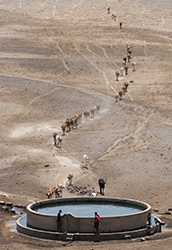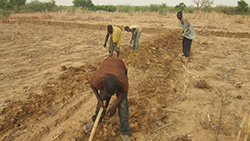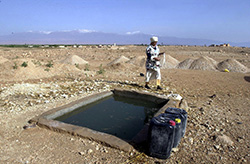Water Harvesting and Storage

Water harvesting (WH) and small-storage technologies are key water-related interventions with the potential to contribute to rapid improvements in the yields of rainfed crops. WH and small-storage technologies can also help provide water for domestic use, livestock, fodder and tree production, and – less commonly – fish and duck ponds.
WH is the collection of rainfall runoff for subsequent beneficial use. Farmers worldwide have been using it for centuries to both reduce erosion and increase crop yields and production reliability. A wide range of WH techniques is available and applicable in various geographical conditions. Many originate locally, and others have been introduced from other regions or countries.
Runoff may be harvested from roofs and ground surfaces as well as from intermittent or ephemeral watercourses. Various classifications of WH techniques exist but, at the broadest level, the term “rainwater harvesting” is applied to those techniques that harvest runoff from roofs or ground surfaces (overland flow), and “floodwater harvesting” is applied to those that collect discharges from watercourses (channel flow).
WH enables farmers to store water when it is plentiful and make it available when it is scarce. Three categories of small-scale storage can be distinguished: 1) soil moisture storage; 2) groundwater storage; and 3) surface storage.

WH techniques that store water as soil moisture work by preventing (or significantly reducing) water runoff from an area using structures to hold water and thus encourage infiltration; this increases the proportion of rainfall entering soil storage, where it can later be used directly by plants. Water that infiltrates past the root zones of crops may percolate into aquifers and be stored as groundwater. Some WH techniques collect runoff to encourage infiltration to increase groundwater storage, and others store water at the surface in natural or man-made ponds or tanks. Water is later withdrawn for irrigation or other productive uses.
Secure access to water with reliable storage has boosted economic growth in many countries worldwide. In many cases, water storage simultaneously serves multiple purposes, such as irrigation, energy generation and flood control.
Many of the world’s river basins are “closed”, with water use equal to or exceeding available renewable water resources, and others are approaching this state. Some countries are contemplating long-distance water transfers to offset local water shortages for multiple needs, while simultaneously aiming to increase water-use efficiency and reduce demand. The rate of water-storage creation in many developing countries in Africa and Asia is considered inadequate, however, for meeting future challenges related to climate change and rising demand for water from other sectors. A lack of water-storage infrastructure may result in heavy economic losses due to flooding and drought and impose high costs on human health from polluted water.

Groundwater use in agriculture has accelerated with the advent of motorized pumps. Today, irrigated areas reliant on water stored as groundwater are estimated to occupy almost 40 percent of the global area equipped for irrigation. This demand for groundwater has helped intensify agricultural production, both in existing surface irrigation commands and on land that would otherwise have no supply. In both cases, the pressure on aquifers is such that many important groundwater systems are now over-abstracted, and the associated loss of water quality is increasing. Moreover, groundwater abstraction with motorized pumps uses large amounts of energy, which is expensive for farmers and – if fossil fuels are used – contributes to climate change.
Given the anticipated impacts of climate change on long-term recharge patterns, it is imperative that the agriculture sector manages demand – both to sustain important zones of precision agriculture and to conserve strategic aquifers as crucial potable water supplies. In many situations, the overexploitation of groundwater can be halted with the development of additional storage capacity that reduces the burden on aquifers and by encouraging farmers and other water-users to attain sustainable abstraction levels.

Dams, both small and large, and their associated reservoirs, can store water for later use, provide hydropower, and offer a certain level of protection against extreme precipitation events. Until recently, there was a lack of enthusiasm among donors to fund storage dams for irrigation, but the food price spike of 2007–2008 led many governments to change their views, and the need for investment in dams and storage is now back on the agenda.
Well-designed dams make water available at times when, in their absence, it would be lacking. On the other hand, dams and reservoirs, especially large ones, can have negative impacts on human societies, for example by requiring resettlement and causing social disruption. Changes in river networks and flow regulation are among the potential negative ecological consequences of dams and reservoirs; in addition, water stored in reservoirs may evaporate at a greater rate than free-flowing water. The design characteristics of dams and reservoirs should be evaluated carefully to minimize such negative impacts and maximize benefits.
By integrating WH and storage structures in landscapes in a planned and systematic manner, it is possible to create a “water buffer” that helps reduce vulnerability to drought and seasonal variations in rainfall: it can be used for multiple purposes, such as agriculture, livestock watering and domestic use.
